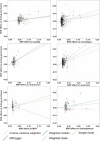Genetics of sleep medication purchases suggests causality from sleep problems to psychiatric traits
- PMID: 37982563
- PMCID: PMC10851853
- DOI: 10.1093/sleep/zsad279
Genetics of sleep medication purchases suggests causality from sleep problems to psychiatric traits
Abstract
Study objectives: Over 10% of the population in Europe and in the United States use sleep medication to manage sleep problems. Our objective was to elucidate genetic risk factors and clinical correlates that contribute to sleep medication purchase and estimate the comorbid impact of sleep problems.
Methods: We performed epidemiological analysis for psychiatric diagnoses, and genetic association studies of sleep medication purchase in 797 714 individuals from FinnGen Release 7 (N = 311 892) and from the UK Biobank (N = 485 822). Post-association analyses included genetic correlation, co-localization, Mendelian randomization (MR), and polygenic risk estimation.
Results: In a GWAS we identified 27 genetic loci significantly associated with sleep medication, located in genes associated with sleep; AUTS2, CACNA1C, MEIS1, KIRREL3, PAX8, GABRA2, psychiatric traits; CACNA1C, HIST1H2BD, NUDT12. TOPAZ1 and TSNARE1. Co-localization and expression analysis emphasized effects on the KPNA2, GABRA2, and CACNA1C expression in the brain. Sleep medications use was epidemiologically related to psychiatric traits in FinnGen (OR [95% (CI)] = 3.86 [3.78 to 3.94], p < 2 × 10-16), and the association was accentuated by genetic correlation and MR; depression (rg = 0.55 (0.027), p = 2.86 × 10-89, p MR = 4.5 × 10-5), schizophrenia (rg = 0.25 (0.026), p = 2.52 × 10-21, p MR = 2 × 10-4), and anxiety (rg = 0.44 (0.047), p = 2.88 × 10-27, p MR = 8.6 × 10-12).
Conclusions: These results demonstrate the genetics behind sleep problems and the association between sleep problems and psychiatric traits. Our results highlight the scientific basis for sleep management in treating the impact of psychiatric diseases.
Keywords: genetics; insomnia; sleep hygiene.
© The Author(s) 2023. Published by Oxford University Press on behalf of Sleep Research Society.
Figures



Comment in
-
Analysis of novel sleep variable highlights shared genetics of sleep and psychiatric disorders.Sleep. 2024 Feb 8;47(2):zsad311. doi: 10.1093/sleep/zsad311. Sleep. 2024. PMID: 38097278 Free PMC article. No abstract available.
References
-
- Ohayon MM. Epidemiological overview of sleep disorders in the general population. Sleep Med Res. 2011;2(1):1–9. doi: 10.17241/smr.2011.2.1.1 - DOI
Publication types
MeSH terms
Grants and funding
LinkOut - more resources
Full Text Sources
Medical
Miscellaneous

